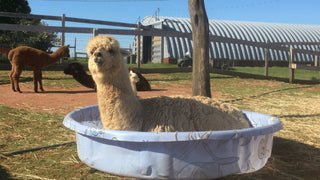Discover the secret language of alpaca fibre production with this beginner's guide to understanding histograms - unravel the mysteries now!
Alpacas are Fibre Producing Animals
Hey there, fellow alpaca, and yarn enthusiasts! Today, we're diving into the fascinating world of alpaca fibre production and shedding light on a powerful tool known as histograms. If you've ever wondered how we decide which animals to breed and how to analyze and optimize the quality of alpaca fibre that they produce, you're in the right place. Histograms play a crucial role in this process, and we're here to break it all down for you in simple, easy-to-understand terms.
Alpacas, beloved for their gentle nature and adorable appearance, are more than just charming companions. These fascinating animals play a crucial role in the world of fibre production, particularly in the creation of luxurious textiles and yarns. Their fleece, renowned for its softness and warmth, and moisture wicking properties, is usually shorn annually in the spring.
Many alpaca farmers will collect fibre samples for histogram analysis during their annual shearing. We collect fibre samples from all our animals every year.


Collecting Alpaca Fibre Samples
Before we can understand histograms, we first need to grasp the importance of collecting accurate fibre samples. When it comes to alpacas, obtaining representative samples is key to assessing the quality of their fibre. You want to ensure that you are taking samples from the same location on all your animals, so that you can make some judgements when comparing animals.
A two-to-four-inch sample of fibre should be collected from the mid-side of each alpaca, shearing the fibre as close to the skin as possible. Consider that the cut end of the sample is the most recent growth, and the outermost tip of the sample was last year’s growth. The length of the sample is called the staple.
Some farmers will collect samples from the hip of the alpaca as well as the mid-side. Keep in mind that alpacas’ prime fleece is in their blanket. Assessing the quality of fibre on the hip can help identify superior fibre producing animals if their histogram data at the hip is similar to that of their mid-side.
Samples should then be placed in a ZipLock bags with the animal’s name, date, sample location, and any other information your diagnostic lab requires.
Analyzing Alpaca Fibre Samples with OFDA2000
Now, let's talk about OFDA2000 – a powerful data analysis tool that revolutionized the way alpaca fibre is analyzed. This nifty tool allows alpaca farmers to obtain detailed information about their alpacas, providing insights that were once impossible to gather by hand.
Using OFDA2000, farmers can measure crucial data points such as Average Fibre Diameter (AFD), Standard Deviation (SD), Coefficient of Variation (CV), and the percentage of fibres greater than 30 microns. This information can then be used to make decisions about breeding and even yarn production.
Without getting too technical, the OFDA2000 measures the actual diameter or thickness of each individual fibre collected. The sample is cut at 3mm increments along the entire length of each staple, and then the diameter of the segment is measured. The diameter is measure in microns (micrometers) which is one one-millionth of a meter – or 1/25,400th of an inch. The symbol is µm and is pronounced, “mew”. For context, average human hair has a diameter of 100 microns.
The result of the analysis is thousands of individual fibre diameter measurements which then can be used to produce both graphical and mathematical statistical analysis.
What’s a Histogram?
In its simplest form, a histogram is a graphical representation of a frequency distribution. That is, it’s a graph with bars where of each bar represents a grouping of measurements that fall within a certain range. The height of each bar represents how many of those measurements fall within that particular range. Histograms are often bell shaped.

Understanding Data Points on an Alpaca’s Histogram
Alright, let's break down these data points one by one:
-
AFD - Average Fibre Diameter
Provides alpaca farmers a snapshot of the overall fineness of their alpaca's fibre. Of the thousands of measurements taken, it represents the mathematical mean of the measurements. A lower AFD typically indicates softer, more desirable fibre. Depending on the lab who does your analysis, you may also see this referred to as MFD or Mean Fibre Diameter. -
SD - Standard Deviation
Measures the spread of fibre diameters within a sample – or how much variation there is in the measurements collected – a smaller SD suggests a more consistent fibre diameter. -
CV - Coefficient of Variation
Quantifies the level of variation in the fibre diameter distribution; and finally -
% of Fibres > 30 Microns
Provides insight into the presence of coarser fibres, which may impact the overall quality of the fleece. In the textile world, garments made from fibre when more than 5% of the fibres are greater than 30 microns in diameter are considered too coarse to be worn next to the skin. For next to skin soft alpaca yarn, alpaca farmers typically use fibres under 25 microns in diameter. -
% of Fibres < 15 Microns
Some analytics labs now include this metric with or instead of the % of fibres >30 microns.
A Word About Alpaca Fibre Grades
In the animal fibre production world, the single biggest determinant of fibre value – whether you talk about, alpaca, sheep, mohair, or angora - is fibre grade or fibre fineness, with finer fibres considered more valuable than coarser ones. Depending on what country you are referring to, fibre grades are given either a numeric or descriptive value to reflect the actual diameter of the fibre.
In Canada, alpaca wool is graded from 1 to 6 where 1 is the finest grade and 6 is the coarsest, broken down as follows:

Our signature yarn, Royal Birch, is made from Royal and Baby fine alpaca fibre harvested from our own herd of alpacas.
Conclusion
Congratulations, you've made it through our crash course on histograms and alpaca fibre production! We didn’t cover everything, but by understanding the role of histograms and data analysis tools like OFDA2000, you're well-equipped to take your alpaca farming to the next level.
Remember, collecting accurate samples, analyzing key data points, and using this information to optimize your herd's fibre quality are all essential steps in the journey towards producing top-notch alpaca wool and yarns. So grab your shears, head out to the pasture, and let's start unraveling the mysteries of alpaca fibre production together!
Questions & Answers
How do histograms assist in assessing alpaca fibre quality?
Histograms are a tool in the alpaca fibre farmer's tool kit to help assess the grade of fibre an animal is producing.
What specific fibre characteristics can histograms reveal?
Histograms can provide data about the grade or fineness of the sample fibre (AFD), the uniformity of the fibre (SD), and an indication of how much of guard or coarse hair there might be (%<30um)
How can understanding histograms benefit alpaca farmers and artisans?
Knowing the grade of fibre an animal produces allows you to compare animals of similar age and colour and to make better breeding decisons and yarn design ones too.



